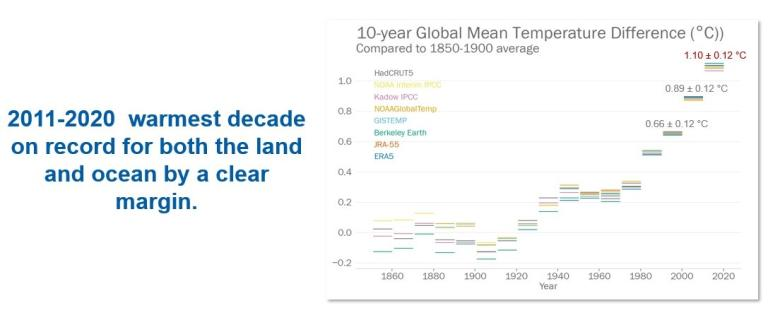Biodiversity & Environment
The Global Climate 2011-2020: WMO
- 06 Dec 2023
- 5 min read
For Prelims: World Meteorological Organization, The Global Climate 2011-2020: A Decade of Acceleration, El Niño event, Greenhouse gases (GHG), Marine Heatwaves, Glaciers.
For Mains: The Global Climate 2011-2020: WMO, Environmental pollution and degradation.
Why in News?
Recently, the World Meteorological Organisation (WMO) has published a report titled- The Global Climate 2011-2020: A Decade of Acceleration, concerning the alarming acceleration of climate change and its multifaceted impacts across the planet.
What are the Key Highlights of the Report?
- Temperature Trends:
- The decade 2011-2020 emerged as the warmest on record for both land and ocean.
- Global mean temperature soared to 1.10 ± 0.12 °C above the 1850-1900 average, with each decade since the 1990s surpassing previous ones in warmth.
- Record high temperatures were reported in numerous countries, with 2016 (due to an El Niño event) and 2020 standing out as the warmest years.
- Greenhouse Gas Emissions:
- Atmospheric concentrations of major greenhouse gases (GHG) continued to rise, especially CO2, reaching 413.2 ppm in 2020, primarily due to fossil fuel combustion and land-use changes.
- The decade witnessed an increase in average growth rates of CO2, highlighting the pressing need for sustainable emissions reduction to stabilize the climate.
- Oceanic Changes:
- Ocean warming rates accelerated significantly, with 90% of accumulated heat stored in the ocean. Warming rates doubled in the upper 2000m depth from 2006-2020, impacting marine ecosystems.
- Ocean acidification due to CO2 absorption posed challenges for marine organisms, affecting their shell and skeleton formation.
- Marine Heatwaves and Sea Level Rise:
- Marine Heatwaves increased in frequency and intensity, affecting about 60% of the ocean's surface between 2011 and 2020.
- Global mean sea level rise accelerated to 4.5mm/yr from 2011-2020, mainly due to ocean warming and ice mass loss.
- Glacier and Ice Sheet Loss:
- Glaciers globally thinned by about 1 meter/year between 2011 and 2020, with unprecedented mass loss, affecting water supplies.
- Greenland and Antarctic ice sheets lost 38% more ice compared to 2001-2010, contributing significantly to rising sea levels.
- Arctic Sea Ice Decline:
- Arctic sea ice continued its decline during the summer melt season, with a mean seasonal minimum extent 30% below the 1981-2010 average.
- Ozone Hole and Successes:
- The Antarctic ozone hole diminished in the 2011-2020 period, credited to successful international action under the Montreal Protocol.
- Efforts led to reduced chlorine entering the stratosphere from ozone-depleting substances.
- Impact on Sustainable Development Goals (SDGs):
- Extreme weather events hindered progress toward SDGs, impacting food security, human mobility, and socioeconomic development.
- Improved early warning systems reduced casualties but economic losses from extreme events escalated.
- The 2011-2020 decade was the first since 1950 when there was not a single short-term event with 10,000 deaths or more.
What are the WMO’s Recommendations for Mainstreaming Action on Climate and Development Goals?
- Enhancing collective resilience against current and future global crises through collaboration and cooperation with international organizations and their partners
- Strengthening science-policy-society interaction to advance synergistic action
- Promoting institutional capacity-building and cross-sectoral and international collaboration at national, institutional, and individual levels, especially for the global South.
- Ensuring policy coherence and coordination among policymakers across sectors and departments for enhancing climate and development synergies at the national, sub-national, and multi-national levels.
What is WMO?
- About:
- It is an intergovernmental organization with a membership of 192 Member States and Territories. India is a member.
- It originated from the International Meteorological Organization (IMO), which was established after the 1873 Vienna International Meteorological Congress.
- Establishment:
- Established by the ratification of the WMO Convention on 23rd March 1950, WMO became the specialized agency of the United Nations for meteorology (weather and climate), operational hydrology and related geophysical sciences.
- Headquarters:
- Geneva, Switzerland.







